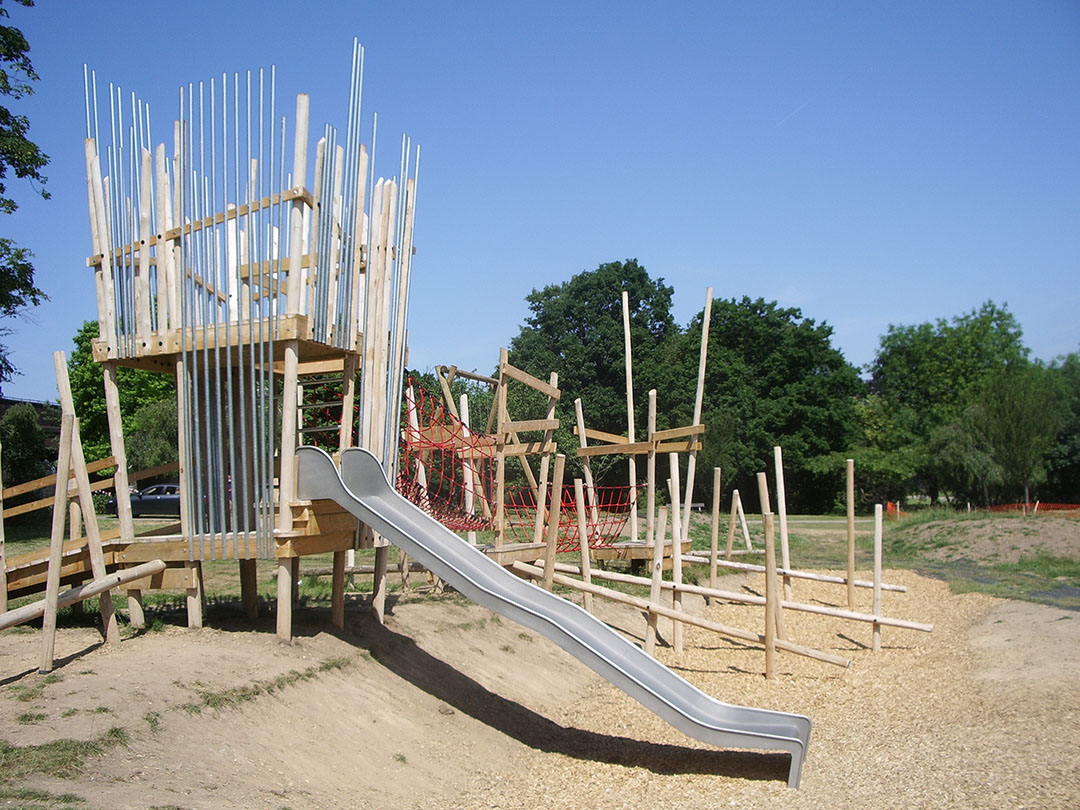Play Naturally, Thrive Uniquely: Child Development, Physical Activities & Motor Skills
Part two of a multi-part article on the magic and benefits of natural playgrounds.

In the first part of our multi-part article on the magic and benefits of natural playgrounds we introduced the ‘Natural Playgound’, the importance they play in children’s development, how they promote physical activity and improve motor skills.
In this second part, we look at how a natural play environment can help foster creativity and imagination and, reduce stress and anxiety.
Fostering Creativity and Imagination
Creativity and imagination are fundamental aspects of children’s development, and natural playgrounds provide an ideal environment for nurturing these qualities. Unlike traditional playgrounds, natural playgrounds offer an unstructured and open-ended setting that stimulates children’s creativity and encourages imaginative play. By incorporating natural materials and providing freedom of exploration, these playgrounds foster a sense of ownership, self-expression, and endless possibilities for play. In this section, we will delve into the unstructured environment of natural playgrounds, the use of natural materials to stimulate creativity and imagination and explore examples of the play and discovery possibilities they offer.
Unstructured Environment of Natural Playgrounds
Natural playgrounds differ from traditional playgrounds in that they offer an unstructured environment. Unlike standardized equipment and prescribed play patterns, natural playgrounds allow children to freely explore and create their own play experiences. The absence of rigid structures encourages children to use their imagination and creativity to shape their play.
In a natural playground, children have the freedom to decide how they want to interact with the environment. They can build, dig, climb, hide, and invent games without predefined rules. This unstructured nature stimulates their creativity, allowing them to take ownership of their play experiences and make choices based on their interests and preferences.
Use of Natural Materials to Stimulate Creativity and Imagination
Natural playgrounds incorporate a variety of natural materials, such as logs, rocks, tree stumps, and branches. These materials serve as open-ended play elements that inspire imaginative play and discovery. They can be transformed, repurposed, and combined in countless ways, providing children with endless possibilities for creative expression.
Logs can become a pirate ship, a balance beam, or a make-believe house. Rocks can be turned into stepping stones, a fort, or a pretend cooking area. Tree stumps can become seats for a storytelling circle, stepping platforms for an obstacle course, or natural tables for a picnic. By engaging with these natural materials, children exercise their imagination, problem-solving skills, and ability to see ordinary objects as opportunities for play and exploration.
Examples of Play and Discovery Possibilities in Natural Playgrounds
Natural playgrounds offer a rich array of play and discovery possibilities. Children can engage in imaginative scenarios such as creating a fairy village, a pirate ship, building a dam in a stream, or constructing a maze using natural elements. They can embark on nature scavenger hunts, exploring the environment to find different textures, shapes, and colours.
Natural elements also encourage sensory exploration. Children can touch, smell, and observe the textures, scents, and sights of the natural materials, fostering a deeper connection with the environment. They can examine insects, observe birds, and learn about the plants and animals that coexist within the playground.
Moreover, natural elements can be combined with children’s ideas and stories to create unique play scenarios. A fallen tree can become the bridge leading to a magical kingdom, and a pile of leaves can transform into a treasure trove waiting to be discovered. The flexibility of natural playgrounds allows children to be the architects of their own play, cultivating their imaginative thinking and storytelling abilities.
In natural playgrounds, children’s creativity and imagination flourish as they engage with the open-ended environment and interact with natural materials. They have the freedom to invent, explore, and discover, fostering a sense of wonder and encouraging their innate ability to think creatively.
Enhancing Cognitive Development
Natural playgrounds provide a rich environment for promoting cognitive growth and scientific knowledge. These playgrounds offer unique educational opportunities for children to learn about the natural world, understand ecological systems, and engage in hands-on experiences. In this section, we will explore how natural playgrounds facilitate learning about the natural world and ecological systems, foster an understanding of interconnectedness, and promote cognitive development and scientific knowledge.
Learning about the Natural World and Ecological Systems
Natural playgrounds offer a unique educational aspect, providing children with opportunities to learn about the natural world. Within the playground environment, children can engage in firsthand experiences and observations of plants, animals, and ecosystems. They can explore the different types of flora and fauna, identify various species, and learn about their characteristics and habitats.
By interacting with the natural elements and engaging in nature-based play, children develop a deeper understanding of the environment and the ecological systems that exist within it. They can witness the interdependence between plants, animals, and their surroundings, gaining insights into concepts such as food chains, habitats, and life cycles. Natural playgrounds become living classrooms where children can immerse themselves in the study of nature.
Understanding the Interconnectedness of Plants, Animals, and the Environment
Exposure to nature and ecological concepts in natural playgrounds helps children develop an understanding of the interconnectedness of plants, animals, and the environment. They begin to grasp the notion that all living things are part of a complex web of relationships. They learn that plants provide oxygen for animals, animals disperse seeds, and both rely on their surroundings for survival.
Understanding the interconnectedness of natural systems promotes cognitive development, including problem-solving skills and critical thinking. Children learn to recognize patterns, make connections, and predict outcomes based on their observations and interactions in the natural playground. They develop an appreciation for the delicate balance of nature and the impact of human actions on the environment.
Promoting Cognitive Development and Scientific Knowledge Research findings and studies demonstrate the positive impact of natural playgrounds on cognitive development and scientific knowledge. Play in natural environments has been associated with various cognitive benefits, including:
- Improved executive function skills, such as decision-making, planning, and problem-solving.
- Enhanced creativity and divergent thinking.
- Heightened attention and focus.
- Increased scientific knowledge and ecological literacy.
Engaging in play within natural playgrounds stimulates children’s curiosity and encourages them to ask questions about the natural world. It fosters a sense of wonder and inquiry, prompting them to explore, investigate, and seek answers. By actively observing and participating in the natural environment, children develop scientific thinking skills, hypothesis formation, and experimentation.
Furthermore, natural playgrounds provide an opportunity for hands-on learning, where children can apply scientific concepts and principles in real-world contexts. They can conduct experiments, observe natural phenomena, and engage in problem-solving scenarios related to the environment. This hands-on approach cultivates a deeper understanding of scientific concepts and encourages a lifelong interest in science and the natural world.
In conclusion, natural playgrounds offer unique opportunities for cognitive development and scientific knowledge. By learning about the natural world, understanding interconnected systems, and engaging in hands-on experiences, children develop critical thinking skills, problem-solving abilities, and a deeper appreciation for the environment.
Reducing Stress and Anxiety
Reducing stress and anxiety is a critical aspect of promoting children’s well-being, and natural playgrounds have proven to be effective in providing a calming and soothing environment. These playgrounds create a unique space where children can escape the pressures of daily life and find solace in the natural world. In this section, we will explore the calming and soothing effects of natural environments, the positive impact of natural playgrounds on children’s mental health and well-being, and the supporting evidence and research studies that demonstrate their therapeutic benefits.
Calming and Soothing Effects of Natural Environments
Natural playgrounds create a unique environment that exudes a sense of calm and tranquility. The presence of natural elements such as trees, plants, and flowing water can have a calming effect on children. The soothing sounds of rustling leaves or a babbling brook, coupled with the gentle breeze and fresh air, create a peaceful atmosphere that helps to reduce stress and anxiety.
The natural environment found in these playgrounds offers a break from the fast-paced, technology-driven world. It provides a space where children can escape the noise, distractions, and demands of everyday life. The serenity of the natural surroundings allows children to unwind, relax, and find solace in the simplicity and beauty of nature.
Positive Impact of Natural Playgrounds on Children’s Mental Health and Well-being
Spending time in natural playgrounds has been linked to positive effects on children’s mental health and overall well-being. Interacting with nature in a playful and exploratory manner has a profound impact on their emotional state and psychological functioning.
Research has shown that exposure to natural environments can alleviate symptoms of stress, anxiety, and attention deficit disorders in children. Nature provides a restorative effect, allowing children to recharge their mental energy and find a sense of inner peace. The natural surroundings create a supportive environment that promotes emotional regulation, reduces feelings of overwhelm, and helps children cope with daily challenges.
Moreover, natural playgrounds offer a sense of freedom and autonomy. Children can engage in unstructured play, follow their interests, and set their own pace. This freedom allows them to escape the pressures of performance and expectations, fostering a positive mindset and promoting a healthy self-esteem.
Supporting Evidence and Research Studies
Scientific studies consistently support the positive impact of natural playgrounds on children’s mental health. Research has shown that exposure to natural environments can improve cognitive function, attention span, and problem-solving abilities. Spending time in nature has been associated with reduced levels of stress hormones and improved mood.
Studies have also highlighted the restorative effects of nature on mental fatigue. Nature-based play has been found to increase children’s ability to concentrate, enhance their working memory, and improve their overall cognitive performance. The exposure to natural elements activates the brain’s attention mechanisms and promotes a state of relaxation and focus.
Additionally, research has shown that access to green spaces and natural environments is associated with better mental health outcomes in children, including reduced rates of anxiety and depression. The visual beauty, biodiversity, and sensory experiences provided by natural playgrounds contribute to a sense of joy, wonder, and connection with the natural world.
The collective evidence demonstrates the therapeutic benefits of natural playgrounds on children’s mental health. The calm and soothing effects of the natural environment, coupled with the opportunities for unstructured play and exploration, create a nurturing space that promotes emotional well-being and helps children develop resilience in the face of life’s challenges.
Concluding our second part of our multi-part article, it’s clear that natural play and natural playgrounds and play spaces can, and do, play a big part in a childs development.
In the next part, our article looks at how natural playgrounds encourage social interaction.
